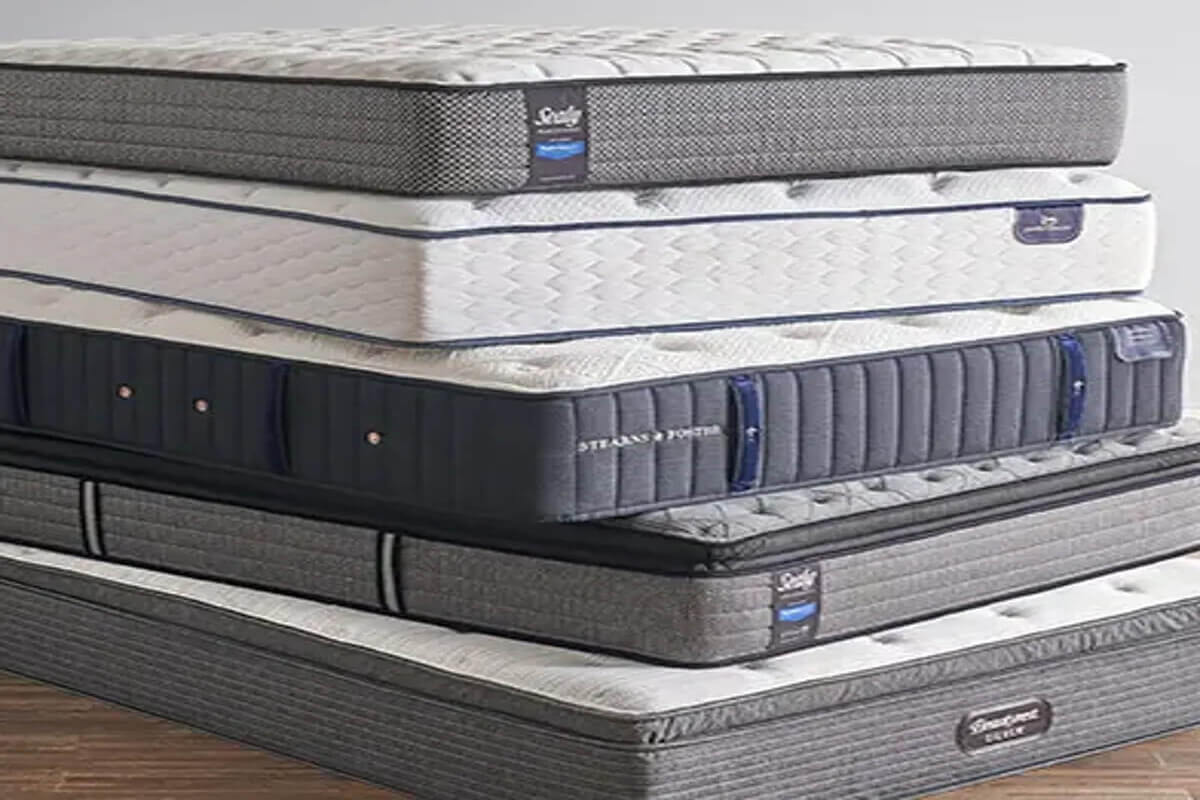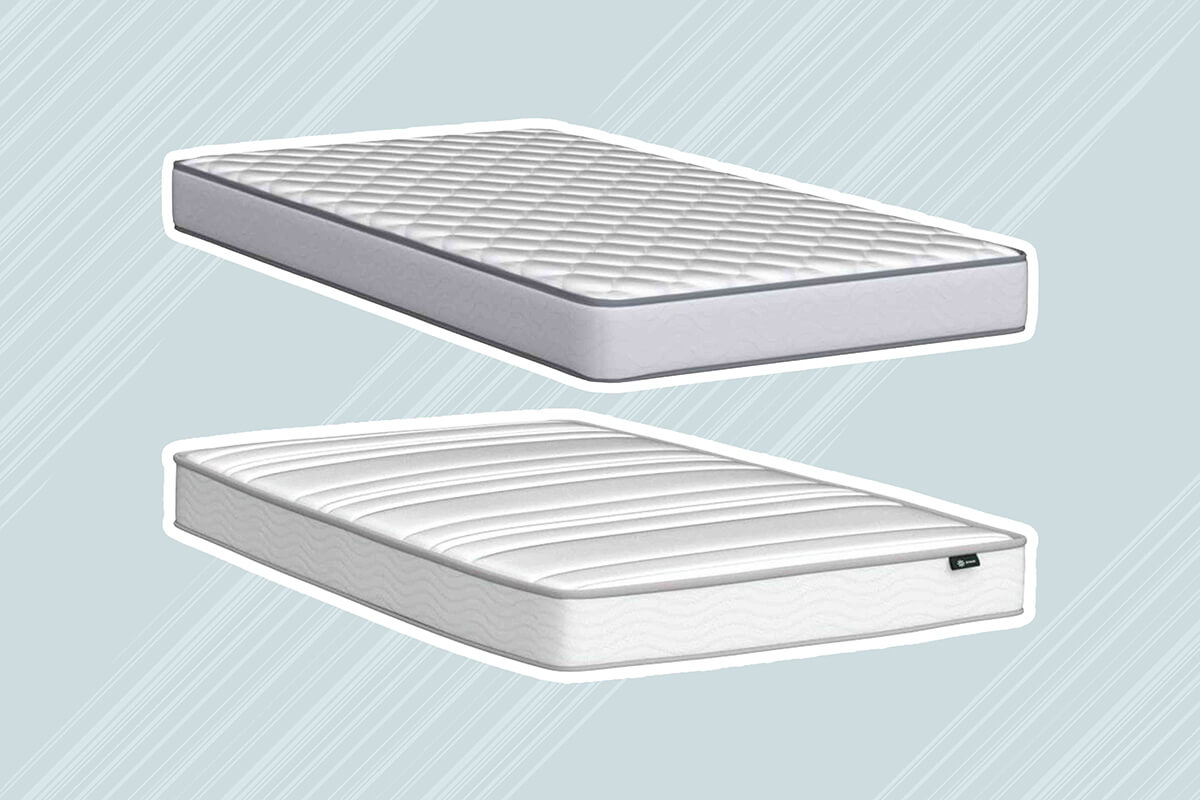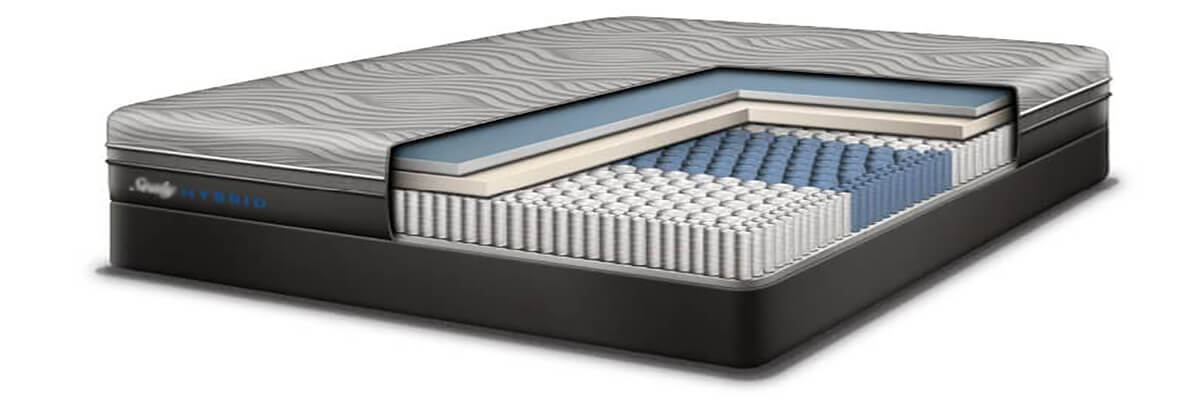Have you wondered what mattresses are made of? Or about the differences between innerspring and foam mattresses? Or what makes a hybrid a hybrid?
With so many mattress options available, a bit of extra information is good to have. Here is an overview of the materials that go into making different beds so the next time you walk into a mattress store, you’ll know what you’re looking at. And you can also talk with your salesperson about exactly what you’re looking for.
1. What’s in a mattress anyway?
Before we uncover the different types of mattress materials, it helps to understand the basic construction of a mattress. Typically, there are three layers to a mattress. A modern mattress should include a support, comfort, and cover layer that encases it all.
The support layer is what gives you support while you sleep. It distributes your weight evenly across the bed surface and keeps your spine in ideal alignment. This layer is typically made from innerspring coils, foam, or a hybrid of both.
Comfort layers give you cushioning on top of the support. When you choose a mattress that is plush, medium, firm, or extra-firm, you’re typically choosing how much comfort layering you want in your mattress, as mattresses’ firmness should have the same level of support beneath the comfort layer(s). The materials for the comfort layers can include memory foam, latex, wool, silk, and other materials.
The covers are the part of the mattress closest to you. These are meant to protect the layers within the mattress to extend longevity. The cover layer also helps prevent the shifting of materials inside the bed by holding the contents of the mattress together.

2. An intro to mattress materials
The following is an introduction to various mattress materials.
1) Steel Coils
When people picture mattress materials, they often first think of steel coils: It seems like they’ve been around forever (almost 100 years)—and for good reason! Innerspring mattresses have provided generations with great sleep. Either open or individually wrapped (also called pocketed coils), they’re a key component when it comes to providing solid support at the base of the mattress. Plus, the way coils are designed allows air to circulate around and through them. And more air circulation means cooler zzz’s.
2) Foam
A cushy, movement-absorbing material that helps keep your body in perfect alignment. Foam in a mattress can give your joints welcome relief from painful pressure. The most common types of foam include memory foam, gel memory foam, and polyurethane foam. Once thought to feel “sluggish” in the way they responded to body movements, today’s foams are highly responsive. They are also excellent for regulating temperature; although older foams were known to trap heat, modern foam mattresses can provide cooling sleep surfaces.
3) Cotton
A highly breathable material is used both inside and on the outside of the mattress. Cotton helps with air circulation to help you sleep cooler. Plus, it can be very durable.
4) Wool
When we think of wool, we often think of it as a material that keeps us warm. When used in a mattress, though, wool allows air to circulate around and through the fibers to help regulate temperature. It’s also used as padding for comfort.
5) Polyester
Often found in fabric blends—along with cotton and spandex—polyester helps create a soft feel and increases durability.

6) Rayon
A common synthetic fiber made from wood pulp—frequently bamboo—rayon is used for softness and to strengthen fabric.
7) Latex
Natural latex (foam rubber) has been used in beds for almost 100 years. (Something for your Gee Whiz File: Firestone used to make foam rubber beds in the 1930s.) It’s most frequently used to make the mattress base strong and supportive. Latex also creates comforting, supportive, and pressure-relieving layers.
8) Adhesives
Used in mattresses to bond layers, materials, and seams together for a perfect fit. Quilting is often used with adhesives to add stability between layers.
9) Flame Retardants
Retardants are found in all mattresses sold in the United States due to strict flammability laws. Though this was once achieved using fire-retardant chemicals, practices have changed, and those chemicals are no longer used in mattresses due to their toxicity. Today, fireproof barriers are placed between layers, and non-toxic chemicals, including boric acid, are often applied to materials to keep them flameproof. Silica, the material that helps make glass, can be infused into bed materials to help them act as a fire barrier.
3. What is a memory foam mattress made of?
Popular for their lush feel, memory foam and polyurethane beds are also known for how well they conform to your body. A newer addition to the memory foam family is gel memory foam which acts as a phase-changing material (PCM)—a fancy term for helping regulate temperature.
Layers of foam material work together to provide support and help relieve your shoulders, hips, back, and knees from painful discomfort. They also help balance your body temp. Plus, these layers absorb movement—also known as motion isolation—so you sleep undisturbed when a bed partner, pet, or child moves on your bed during the night.
Covers used on memory foam mattresses are typically stretch knit covers. They allow you to settle comfortably into the foam beneath it. With the cover working its magic on top, higher-density foams are used as the core layers of the bed. Those are the layers that determine the overall feel (how soft or firm it is), keeping your spine aligned and preventing sagging.
There was a knock on early memory foam beds: They responded slowly to body movements. If you grew up sleeping on an innerspring bed (and most of us did), the sluggish response of foam material might have turned you off when it came to buying one. Or, if you did try one, the feel took some major adjusting. But today’s memory foam beds have become much more responsive—often comparable to the “bounce” a spring bed provides.

4. What is an innerspring mattress made of?
Innerspring mattresses come in two different systems: open coil or individually pocketed springs. Open coils have nothing surrounding them, and they’re frequently attached to each other. Pocketed coils are wrapped individually with any of a variety of fabrics, including cotton or synthetic materials.
The advantage of pocketed coils is they move independently of each other. That translates to superior support, minimal motion transfer, and more comforting contouring for your body.
Open coils are often tied together, so they respond to movement in groups. This means they’re less responsive to movements made by individual body parts like your shoulders, hips, and back. So, a depression created by your hips, for example, could extend as far down the bed as your thighs at one end and your torso at the other. With pocketed coils, when your hips sink into the bed, for example, the depression is at your hips—nowhere else.
When you shop for an innerspring bed, it’s important to remember a higher coil count—especially for pocketed coils—can improve motion separation and pressure relief. Why? It all comes back to the effective and efficient individualized response they offer.
Did you know there is memory foam in today’s coil beds? Each manufacturer uses different kinds of foam, including memory and polyurethane. More luxurious innerspring mattresses will use temperature-regulating gel memory foam and latex.
5. Innerspring mattress cover materials
Outer quilting is typically made of traditional cotton fabric, allowing for more airflow to help you sleep cooler and drier.
Cover materials can range from polyester to cotton or stretch knit, each one specifically designed to be soft and breathable.
1) Supportive Edges
When you wake up and get ready for the day, edge support materials are important. For many of us, the side of the bed is where we sit to put our shoes on in the morning. To create a firm, supportive edge—bedmakers use materials ranging from thick metal rods to foam inserts and encasements.
A firmer edge also helps extend the sleep surface of your bed. Plus, a strong edge prevents the dreaded roll-off feeling you might get with older and less-expensive mattresses.
6. What is a hybrid mattress made of?
Hybrid beds are among the latest and greatest options for better sleep. That’s because of the many unique benefits hybrid mattresses offer. Specifically, they’re a 50/50 combo of individually wrapped coils and memory foam that give you the best of both.
While coils offer support, memory foam, and gel memory foam layers conform to your body, providing pressure relief and regulating body temperature.
1) Hybrid Mattress Cover Materials
Hybrids tend to have a more elastic mattress cover to prevent interfering with the softness and conformation from memory foam layers. Many hybrid beds are designed with high-density foam encasements to help create a strong, supportive edge.

7. What is a latex mattress made of?
Latex is made from the sap of rubber trees and has been used by bed manufacturers since the 1920s. Contrary to popular belief, latex mattresses aren’t made from one big piece of rubber. Today, these beds are made of naturally hypoallergenic layers of latex foam that vary in thickness and density. Together, they deliver a truly luxurious feel. That’s what makes latex mattresses strong performers when it comes to comfort and pressure relief. Plus, eco-friendly latex layers are extremely durable.
1) Latex mattress cover materials
Cover materials for latex beds are made with a range of materials. Like innerspring and memory foam beds, covers are often made with cotton and polyester. As you look at latex beds, you’ll also see covers made of bamboo, wool, and silk for softness and stimulating airflow.
8. What are air mattresses made of
The ingredient common to all airbeds is (wait for it…) air! After that, a variety of inflatable materials are used. The most common? PVC. Although you’re probably most familiar with PVC for pipes, the air mattress version is soft, pliable, and durable. Rubber and rubber composites are frequently found in higher-end airbeds.
Although not a material, the pump for airbeds is a critical component. Today’s better air mattresses no longer rely on lung power to fill them. Foot pumps and pumps with small motors have taken over that responsibility. And everyone who has spent considerable time and energy getting red in the face (and occasionally dizzy) blowing up an air bed is grateful.
9. What are organic and eco-friendly mattresses made of?
Over the last 10 years or so, socially and environmentally-conscious mattress buyers have been looking for organic and eco-friendly beds—and many manufacturers responded to this growing interest with a variety of quality brands to shop and bed options to choose from.
At their most basic level, organic and eco-friendly mattresses are made with materials that aren’t harmful to the environment. But, with so many bed manufacturers making claims of being “green” and good for the planet, it can be tough to separate true organic materials from the not-so-true.
High-quality organic and eco-friendly beds are most commonly made with certified organic cotton, wools, latex, hemp, and other renewable materials, along with adhesives and fire retardants—with emphasis on certification.
Material authentication comes in the form of certification from organizations that are basically keepers of the planet when it comes to identifying true organic materials. And when you shop for an eco-friendly mattress, you’ll want to look for—and find—certifications from agencies including Certipur-US, Global Organic Textile Standard (GOTS), USDA Organic, and Global Organic Latex Standard (GOLS).
One component of eco-friendly beds can be innerspring. And there’s no such thing as organic steel. But! You’ll want to look for coil systems made with either recycled coils or coils that can be recycled when the time comes to dispose of your mattress in a socially conscious way.

10. Factors to consider when buying a mattress
Finding a mattress to improve your sleep is all about your sleep position, physical challenges such as joint pain or allergies, the comfort level you’re after, and, of course, your budget. Somewhere out there is the bed you’ve been dreaming of—we promise!
As a starting point in your search for a new mattress, consider the following when you’re shopping: For side sleepers, medium and plush mattresses will allow your shoulders and hips to ease into the top layers to relieve achy joints.
Back and stomach sleepers generally benefit from a firmer-feel bed. This additional support prevents your back from sinking into the mattress surface, which can make sleeping painful. If you sleep on your stomach, a firmer bed will prevent your hips from sinking into the surface, creating a painful arc in your body position with your lower and upper body more elevated than your midsection. Additional support targeted in the center of the bed will help you sleep more comfortably—and soundly.
Knowing these basic building blocks of mattresses can help ensure your next bed has all your favorite ingredients for a good night’s sleep.
11. Conclusion
This guide explains what mattresses are made of and the ingredients used to make different types of mattresses, so you can now choose the right mattress for yourself.





Leave A Comment